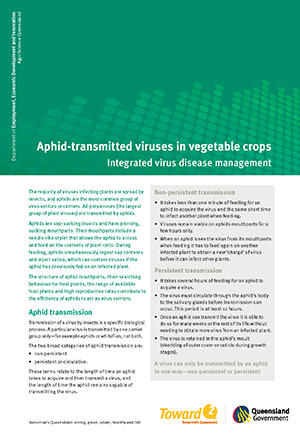|
|
Aphids are the most common group of insects that transmit plant viruses. All potyviruses are transmitted by aphids. This 4 page factsheet describes virus transmission by aphids and the best management strategies to minimise crop damage. The impact of viruses can be reduced by developing integrated management systems targeting the viruses, their active insect carriers and alternative host plants which can harbor viral diseases. Authors : Key Points : Aphids are sap-sucking insects and have piercing, sucking mouthparts. Their mouthparts include a needle-like stylet that allows the aphid to access and feed on the contents of plant cells. During feeding, aphids simultaneously ingest sap contents and inject saliva, which can contain viruses if the aphid has previously fed on an infected plant. The structure of aphid mouthparts, their searching behaviour for host plants, the range of available host plants and high reproductive rates contribute to the efficiency of aphids to act as virus carriers. Transmission of a virus by insects is a specific biological process. A particular virus is transmitted by one carrier group only—for example aphids or whiteflies, but not both. A virus can be transmitted by an aphid in only one of two ways; persistent or non-persistent. This refers to the length of time an aphid takes to acquire and remains capable of transmitting the virus. The majority of aphid-transmitted viruses affecting vegetables are transmitted in a non-persistent way. It is difficult to manage aphid-transmitted viruses:
Plants cannot be cured once infected by a virus. Instead, disease management aims to prevent or delay the infection of plants and minimise economic losses. Although no single method is likely to provide adequate control, integrating several management options will often provide effective control. See Also : Acknowledgements : This technical reference note has been produced by Denis Persley and Cherie Gambley (DEEDI) as part of the Horticulture Australia Limited project VG-07128-Integrated management of viral diseases in vegetables. This project has been facilitated by State Governments, and Horticulture Australia Limited (HAL) in partnership with AUSVEG through the National Vegetable Research and Development Levy. The Australian Government provides matched funding for all HAL’s R&D activities. |
|

